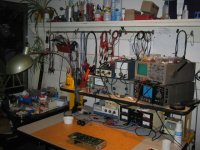Sorry for that maybe kinna "trivial" question, but there's allways good ideas underneath I think.
Here's mine, a usefull test bed/setup i like having is:
> An AC mVmeter that I can connect everywere (from 1mV/-60dBm to 300V/+50dBm) which, through its internal amplifier is feeding the oscilloscope (also connected to the source, this is the bottom scope)
> An AF wobulator (is this the right translation of the french wobulateur ??? it's home made with a returm amplifier) connected X/Y to the upper scope (which also serve as a component tester)
> Maybe I can also mention, the X/Y on power grids trick for phase inverters testing.
this setup provides me a great gain of time compared to before.
any tricks to share ?
(don't trust too much the picture, this place is most of the time a mess )😉
Here's mine, a usefull test bed/setup i like having is:
> An AC mVmeter that I can connect everywere (from 1mV/-60dBm to 300V/+50dBm) which, through its internal amplifier is feeding the oscilloscope (also connected to the source, this is the bottom scope)
> An AF wobulator (is this the right translation of the french wobulateur ??? it's home made with a returm amplifier) connected X/Y to the upper scope (which also serve as a component tester)
> Maybe I can also mention, the X/Y on power grids trick for phase inverters testing.
this setup provides me a great gain of time compared to before.
any tricks to share ?
(don't trust too much the picture, this place is most of the time a mess )😉
Attachments
Dell Inspiron 9300 notebook with Tascam US-122 sound adapter, Hitachi V-555 oscilloscope, Wavetek 154 signal generator, HP 4000 vacuum tube voltmeter, Marconi TR 2091B noise generator, couple of handheld voltmeters, Atten F1000-C frequency counter. And lot of transformers, tubes, transistors, capacitors, etc... Soldering tools 30W, 60W, 120W.
Your mess looks like a good setup to work, I'll not post mine, it is the real mess. 😉
Your mess looks like a good setup to work, I'll not post mine, it is the real mess. 😉
bembel said:are you operating at home too ?
Yes, Collins R-392 and Bendix (or Stewart Warner?) BC-348-R with solid-state 2'nd IF converter with synchro detector (SS AM tuner connected to the grid of the last IF tube, actually) 😉
- Status
- Not open for further replies.
